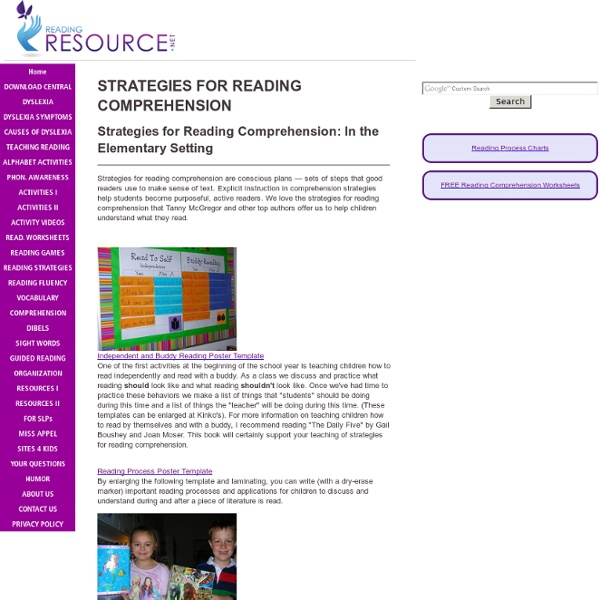Strategies for Reading Comprehension
Strategies for reading comprehension are conscious plans — sets of steps that good readers use to make sense of text. Explicit instruction in comprehension strategies help students become purposeful, active readers. We love the strategies for reading comprehension that Tanny McGregor and other top authors offer us to help children understand what they read. Reading Process Poster Template By enlarging the following template and laminating, you can write (with a dry-erase marker) important reading processes and applications for children to discuss and understand during and after a piece of literature is read. READ-O As mentioned on the Reading Fluency Activities Page, students are encouraged to read each night at home with their families and keep track of the books they read. Strategies for Reading Comprehension Template Use the above template to display the strategies for reading comprehension in your classroom.
Reading Is Thinking
untitled
Comprehension Strategies
Reading comprehension refers to the students' ability to read and understand information presented in written form. Reading is not a passive activity. Good readers interact with text, making and validating predictions, creating questions about the characters, main idea or plot, monitoring their own understanding of the text, clarifying the confusing parts, and connecting text events to their own prior knowledge and experiences. All teachers must teach students the comprehension skills necessary to help them understand text and be successful independent readers. Think Aloud Reciprocal Teaching Teacher Read Aloud Cloze Procedure Literature Circles Keys to Comprehension On the Web: Reading Comprehension Strategies A New Way to Teach Reading Comprehension Early Literacy Reading Resources Intel Teach Program: Strategy Bookmarks Teach 21 Home
Notes on Strategies for Reading Comprehension
Share Book Recommendations, Join Book Clubs, Learn more about your Favorite Books and Share Books with Friends.
Virtual Musical Instruments: play the guitar, piano, drums and flute.
Using the Comprehension Strategies Notes
Embarrassed to Read by Donalyn Miller
A recent National Literacy Trust report found that 17% of children surveyed would be embarrassed if their friends saw them reading. According to a dictionary, “Embarrassment is an emotional state of intense discomfort with oneself, experienced upon having a socially unacceptable act or condition witnessed by or revealed to others.” Embarrassment is tied to our need for social acceptance. So, where do children learn that reading is embarrassing? Children receive the message that reading a lot isn’t cool from adults. In modern society, children’s future success depends on their acquisition of literacy skills. I fight this perception that reading is nerdy with my students every year. As adults, those of us who love books and reading often gravitate toward other readers. If cultural acceptance includes reading, then children will read. People who read avidly as adults do so because we enjoy it. Donalyn Miller is a fourth grade teacher at Peterson Elementary in Fort Worth, TX. Like this:
Creativity Resource for Teachers » Teaching Resources
21st Century Skills Resources RSA Animate: 21st Century Enlightenment The Royal Society for the Encouragement of Arts, Manufactures and Commerce (RSA), formed in the 18th century, is a network of people devoted to creative thinking for social progress. In this video, RSA Chief Executive Matthew Taylor explores what 21st century enlightenment means, and how it can help navigate today’s challenges differently than established modes of thought. The Partnership for 21st Century Skills This is the advocacy website for the implementation of 21st Century Skills. Arts Integration: The Authentic Context for 21st Century Learning This article details how arts integration offers unique and successful methods for instilling 21st Century Learning Skills across the curriculum. Useful Websites for Teachers Art Museums ArtNC This North Carolina Museum of Art website is designed for educators, students, and anyone interested in looking and learning from works of art. ArtsConnectEd ArtThink ArtBabble WatchKnowLearn
Using the Comprehension Strategies
Students review the six major reading comprehension strategies and then take the strategies into action in more complex reading. We also discuss a seventh strategy, monitoring comprehension. Directions Step 1: Review the six reading comprehension strategies by using all during a modeled think-aloud reading. I use an overhead of a short passage found in an old science textbook that is no longer in use. The six strategies are: ConnectingVisualizingQuestioningInferringDetermining Importance in textSynthesizing Your goal in this mini-lesson is to show students how you integrate all these strategies to gain understanding of a text. Step 2: Explain that the seventh reading strategy is called monitoring comprehension. How do you know when it doesn't make sense? Step 3: Have students read a section or partial chapter from a textbook they are using in another class. Step 4: Ask each student to map the comprehension strategies that they used to better understand the text. Supporting All Learners
We Read, We Blog, We Teach
RebelMouse: Let Your Content Roar
Related:
Related:




I was searching particularly for sites with ideas on how to make great reading comprehension posters. This one has some really good. My favorite is the giant Q question poster reminding the kids to ask questions as they read. Might be a good idea to do the same thing, but with a ? instead of a Q. by jezzri Oct 30